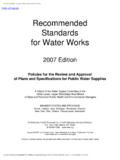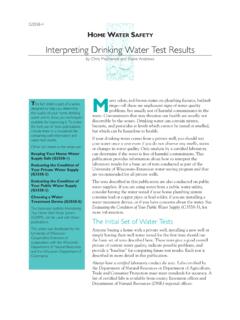Transcription of CHAPTER 6. MECHANICAL SYSTEMS PERFORMANCE …
1 CHAPTER 6. MECHANICAL SYSTEMS PERFORMANCE OBJECTIVES 6-1. GENERAL. MECHANICAL SYSTEMS shall be consistent with the MPS and provide project sites and buildings with the following services: a. Proper temperatures within buildings and spaces to maintain health, comfort and system safety without excessive energy usage as defined herein; b. Ventilation of dwelling and public spaces to maintain health and sanitary spaces; c. Required ventilation of MECHANICAL and structural areas to insure safe system functioning; and d.
2 Plumbing SYSTEMS for the storage, supply, distribution and drainage of water , and sewage SYSTEMS required to maintain safe and sanitary sites and buildings. 6-1 2/85 SECTION 1: MANDATORY STANDARDS 6-2. MECHANICAL EQUIPMENT a. Operation. MECHANICAL equipment shall be safe and efficient to operate and durable, dependable and economical to maintain. Equipment shall operate within appropriate noise levels so as not to interfere with tenant use of buildings and spaces.
3 MECHANICAL equipment shall be provided with ventilation for combustion and maintenance of safe ambient temperatures. b. Location. Equipment, panels and MECHANICAL rooms shall not be accessible to unauthorized personnel. Equipment not located within MECHANICAL rooms shall be protected by vandal-resistant cages or other equivalent means. MECHANICAL rooms shall be provided with self-closing locks with free knobs on the inside, with access by key only. For technical requirement for doors, see paragraph 10-7.
4 MECHANICAL and electrical rooms shall be separate, sole use spaces. These rooms shall not be used as passageways, storage areas or for any other purpose. MECHANICAL rooms and equipment shall be illuminated for safe and convenient use, inspection and maintenance. 6-3. HEATING. Heating facilities shall be provided for interior residential, community, public and utility spaces where MECHANICAL heating is considered necessary to provide comfort and system safety. a. Space Temperatures. Set-back thermostat controls shall be provided when cost-effective.
5 New or replacement thermostats installed in habitable spaces shall be factory set for a maximum temperature of no more than 75F for elderly dwelling units and 72F for non-elderly dwelling units. Thermostat controls that are to be moved should not be located in public areas ( , hallways, etc). Where conditions necessitate placement of thermostats in public spaces, these units shall be tamper resistant. (1) Habitable Spaces. In family projects, the heating system for habitable spaces shall be capable of attaining 65F based upon outside design temperature.
6 In elderly projects, the heating system for habitable spaces shall be capable of attaining 75F based upon outside design temperature. 2/85 6-2 NOTE: Dwelling unit thermostats should be inspected for proper placement. Inaccurate space temperature reading may be caused by location of thermostats on outside walls, adjacent to exterior doors, windows, or cooking areas. (2) Non-Habitable Spaces. Maintenance, MECHANICAL and other non-habitable spaces shall be maintained at a temperature that provides adequate working conditions and safe system functioning.
7 B. Space Heating Equipment. Space heating equipment shall be retrofitted with energy conservation devices that are cost-effective, such as: o Electric and electronic pilots; o Flue damper; o Duct heat recovery device; o Reduced oil nozzle size; o Tenant fuel metering; o Replacement of obsolete equipment; o Setback thermostat; or o Other. (1) Individual Gas or Oil Heaters. Individual gas and oil heaters shall be connected to an approved vent, flue or chimney, and shall have adequate air supply for complete fuel combustion.
8 Heaters shall be protected to prevent unsafe human contact or fires and have clearances around them. Floors beneath equipment shall be protected against fire and deterioration. Screening shall not minimize required ventilation to the space heater. When provided new or replaced, individual controls or units shall not be positioned near the floor, especially in elderly projects or in units for the handicapped. (2) Open Flame Heaters. Open flame radiant space heaters shall not be used.
9 C. Central Heating Equipment. Central heating equipment shall be retrofitted with energy conservation opportunities and devices that are cost-effective, such as: 6-3 2/85 o Flue heat recovery; o Insulation; o Turbulators; o Replacement of obsolete plant; or o Other. d. Central Distribution SYSTEMS . All heating elements shall be protected to prevent unsafe human contact or fires. Heating distribution SYSTEMS shall be retrofitted with energy conservation devices that are cost-effective, such as: o Individual hydronic controls; o Zone control; o Insulation of hot water and steam piping; o Boiler control from outdoor temperature; or o Other.
10 6-4. DOMESTIC HOT water . a. SYSTEMS . Domestic hot water heater SYSTEMS shall have the capacity to maintain a minimum water temperature of l00F The maximum water temperature shall not exceed l20F at the tap for typical dwelling unit use. Heaters shall be connected to an approved vent, flue or chimney and shall have adequate air supply for fuel combustion. Domestic hot water heating SYSTEMS shall be with retrofitted energy conservation devices that are cost- effective, such as: o Jacket insulation for electric heaters; o Off peak control of electric water heaters; o Solar collector SYSTEMS ; o New high-efficiency water heater replacement; or o Other.














